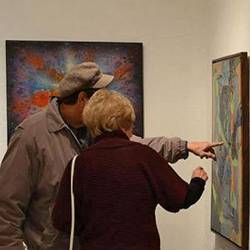
Researchers at Purdue University have come up with a video surveillance system driven by artificial intelligence (AI) that can message people on their smartphones based on how they are moving.
The system can detect an art lover at a museum pointing to a specific painting, for example, and then immediately send a message to that person's smartphone offering the complete background of the artist who created the painting, its genre, its place in art history, and related insights.
"Our system serves as a bridge to connect surveillance cameras and people," says He Wang, an assistant professor of computer science at Purdue University who developed the AI-driven software with his graduate research assistant, Siyuan Cao.
Essentially, the system's AI software has been trained to recognize specific types of movements—such as pointing, walking, or reaching for an object—and then send a message to the smartphone of the person engaged in that activity. The system has also been trained to recognize if a smartphone is in motion or stationary.
In order to receive a message, the recipient needs to pre-install the system's client software on his/her smartphone, which activates a communication link between the AI-driven video cameras and the smartphone handset.
Ingeniously, Wang and Cao designed the system, dubbed PHADE (for Private Human Addressing), to ensure users retain their privacy, even while being surveilled by the video cameras. They were able to do this by training the software to recognize certain types of movements only, and to ignore personal details associated with the specific individuals engaged in making those movements.
When the system sends a message to the art lover in a museum who is pointing at a painting, for example, the software has no recognition of who is actually doing the pointing, or even what he or she looks like. Instead, the AI-driven video surveillance cameras only perceive that a certain kind of motion is occurring, whereupon the software sends a message to the anonymous person engaged in that activity.
The researchers say they protected the individual's privacy by making it difficult for the software to track anyone's walking history over time. The software focuses on perceiving specific, isolated motions, rather than creating an archive of those motions over time, according to He.
Moreover, the researchers also programmed the software to fine-tune which smartphones receive messages from the system, and which smartphones never see those messages. For example, when the system perceives a supermarket customer lingering over an ice cream bin, possibly considering whether or not to reach in for that gallon of Rocky Road, the system can send an ice cream coupon to the phone of that one shopper, even if 10 other shoppers happen to be passing by at the same time.
The researchers were able to pull off that specificity by using an enhanced version of the User Datagram Protocol (UDP) messaging format, a standard commonly used to broadcast messages to smartphones, according to He. While broadcasting a message to the ice cream lover in standard UDP would ordinarily send the coupon to that person as well as anyone else near the ice cream bin, He and Cao's software enhances that messaging by 'tagging' the UDP message with a qualifier that requires the smartphone to be stationary in order to receive the coupon (which it knows by contacting the motion sensors in all nearby smartphones).
Purdue is in the process of patenting the system, according to Cao, who adds, "Some companies working on smart cities and commercial apps have contacted us and showed interest in deploying PHADE."
Adds He, "In the future, we may see PHADE embedded into some apps or even operating systems to extend their current functions."
Both researchers see great potential for the system in public safety, since it could be programmed to allow public safety authorities, for example, to warn someone in a crowd about a potential threat, such as a suspicious follower or the approach of a hostile vehicle.
He and Cao also see shopping malls and supermarkets as natural environments for PHADE, where shoppers could be sent customized messages and coupons based on the stores they happen to be passing by or the specific items they happen to be ogling.
"The content of the messages may also be determined by the customer's shopping behaviors like hesitating, wandering, or staring," Cao says.
Even gyms could leverage the messaging technology, relying on the AI-driven video cameras to watch for specific types of movements during a workout, then sending the people performing those movements coaching messages.
"I like the overall idea of 'contextual address', which is a nice, new direction of research," says Shahriar Nirjon, an assistant professor of computer science at the University of North Carolina at Chapel Hill, who is well-acquainted with He and Cao's work.
Besides individual-specific messaging, Nirjon also sees a number of applications for PHADE in group messaging. "For instance, the system can send tailored messages to different groups of users to distribute and guide them to the right direction in a disaster/evacuation scenario, or after a concert or a game," he says.
Joe Dysart is an Internet speaker and business consultant based in Manhattan, NY, USA.



Join the Discussion (0)
Become a Member or Sign In to Post a Comment